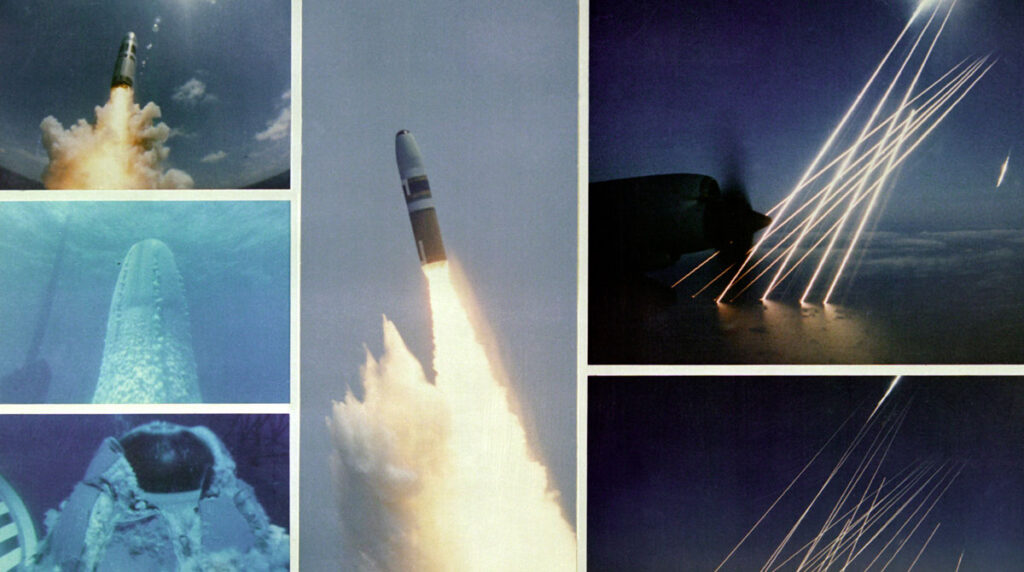
Gambling With Armageddon: Nuclear Roulette From Hiroshima to the Cuban Missile Crisis by Martin J. Sherwin; Knopf, 624 pp., $35
It has now been 75 years since a few thousand pounds of TNT threw its explosive energy upon a mere 140 pounds of uranium in a tight metal can over the Japanese port city of Hiroshima, causing nuclear criticality, and introducing the world to the calamitous physics of bonds between atoms. The “Little Boy” bomb was followed by “Fat Man,” which, using a different spark plug, destroyed Nagasaki a few days later.
The thin version of Western nuclear history supposedly goes like this: The American bombs ended World War II. The Soviets developed a nuclear capability of their own, and then an arms race began. In 1962, the Soviets secretly tried to install nuclear missiles in Cuba. President Kennedy called them on it. A tense confrontation followed, but the leaders compromised. Then President Reagan won the Cold War by forcing the Soviets into submission (or maybe they were overextended—minor details, really), and huge stores of nuclear warheads were dismantled. We enjoyed a period of peace, brought to an end by the 9/11 attacks, and fretted over the possibility of nuclear terrorism. Then, in 2006, the world was compelled to accept the rise of North Korea as a nuclear power. Folks seeking to justify the presence of nuclear weapons on this planet will tell you that, whatever the original impulses behind the Manhattan Project, the subsequent 75 years have borne out the proposition that large arsenals, presidential leadership, and skilled diplomacy have prevented these weapons from being used. In some ways, the Cuban Missile Crisis has become central to the catechism of this nuclear priesthood. Both sides knew the stakes. Both sides knew the risks. Political leaders puzzled through the geopolitical ramifications, and, in the end, they compromised.
But Pulitzer Prize–winning historian Martin J. Sherwin contends that this history is almost entirely false. One of our ablest chroniclers of the larger-than-life personalities and lasting environmental effects of the nuclear age, Sherwin revisits the Cuban Missile Crisis in Gambling With Armageddon, drawing in part on his own firsthand experience. In October 1962, Sherwin was an intelligence officer for an antisubmarine warfare squadron based in San Diego. On Monday, October 22, in the middle of the crisis, he handled the top secret orders from the Pentagon that told his commander what to do and where to do it in the event of a war with Russia. While Kennedy and Khrushchev sweated through their shirts and sent letters back and forth (the “hotline” between Washington and Moscow was not yet established), their militaries mobilized for war.
Nuclear war, Sherwin came to learn, was something that the military had to stop; once set in motion, it would happen. The logic of nuclear conflict dictates this: one has to start the war in order to be the one who might (in theory, if there’s enough of anything left) be in a position to end it. Practically, this meant that the commanders of the four nuclear-armed Soviet submarines dispatched to Cuba had been issued orders spelling out the conditions under which they could launch their missiles. But critical information was missing: the United States had announced that it would enforce its quarantine of Cuba by dropping explosives “in the vicinity” of any submarines it encountered. The U.S. Navy assumed that the Soviets would pass this this warning along to their submarines, but the Soviets failed to do so. Likewise, no one bothered to tell U.S. naval commanders that the Soviet boats they were about to encounter had been armed with nuclear weapons and, if challenged, had orders to use them.
So it wasn’t Kennedy or Khrushchev controlling the fate of the world on October 21, 1962. It was an exhausted, confused Soviet submarine commander, who had to decide, unilaterally and against orders, not to launch a nuclear weapon.
Sherwin recounts this story, which is new, as the prelude to his exhaustive history of how the superpowers found themselves locked in a grim test of wills. He identifies the Hiroshima bomb as the origin of the conceit that political leaders controlled (or could control) nuclear escalation. He is correct to point out the date as well as the conceit. But there have been many nuclear near-misses over the years, almost of all of them the result of mistakes by ghosts in the machine—and many prevented only by young men in uniform, whose guts told them to pause and question direct or standing orders.
Most of the book will be familiar to students of the period. Sherwin recounts the litany of failures by the CIA (and the Navy’s intelligence arm) in almost maddening detail—maddening because one wonders what the intelligence community was doing if not tracking Soviet nuclear warheads. By then, though, intelligence collection had taken a backseat to the CIA’s emerging use as a paramilitary organization, which, in Cuba resulted in the loss of millions of dollars and many lives in failed attempts to overthrow Fidel Castro. Sherwin’s book is somewhat burdened by distracting and intrusive digressions, but his central point, passionately underscored, is all too clear: the peaceful resolution of the Cuban Missile Crisis did not result from adroit diplomacy or cooler heads prevailing in Washington and Moscow. It was dumb luck.

